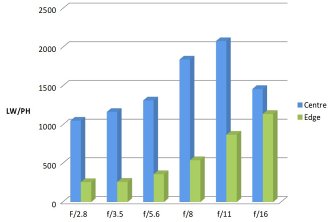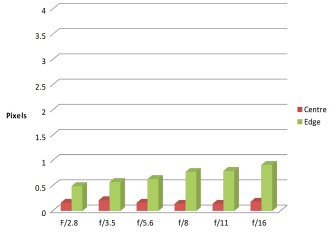Meike 12mm f/2.8 Review
Meike 12mm f/2.8 Performance
The sharpness figures do not really do justice to the lens. Because the lens to chart distance is so close the best performance is not being found and shots taken of 3D subjects at more normal distances look much sharper than the figures would suggest. Field curvature may well be a factor in this.
At the centre, sharpness measures as only fair from f/2.8 to f/5.6. However, it sharpens up and is very good at f/8 and f/11. Sharpness remains of a good standard at f/22.
The corners are soft throughout, very soft, only becoming fair at f/22. Clearly, though, looking at the real world images, results are better when 3D subjects are shot and the field curvature brings the edges into better focus. It is not a lens that does well with flat charts.
How to read our charts
The blue column represents readings from the centre of the picture frame at the various apertures and the green is from the edges.The scale on the left side is an indication of actual image resolution as LW/PH and is described in detail above. The taller the column, the better the lens performance.
For this review, the lens was tested on a Panasonic Lumix G6 using Imatest.
CA (Chromatic aberration) is one of the design strengths. At the centre, correction is of a very high order and even at the edges it is controlled to within one pixel. Software can easily be used to correct this anyway.
How to read our charts
Chromatic aberration is the lens' inability to focus on the sensor or film all colours of visible light at the same point. Severe chromatic aberration gives a noticeable fringing or a halo effect around sharp edges within the picture. It can be cured in software.Apochromatic lenses have special lens elements (aspheric, extra-low dispersion etc) to minimise the problem, hence they usually cost more.
For this review, the lens was tested on a Panasonic Lumix G6 using Imatest.
Looking at flare, we immediately hit a significant weakness. Even the slightest hint of a light source such as the sun at the edge of the frame simply wipes out the image. Provided the light is watched and against the light shots are avoided or handled by standing in shade then contrast is very good, but the merest hint of strong light on the lens and the image disappears in a haze of purple.
Barrel distortion is expected in wide lenses and here measures -0.83%, a good result for this design. This can be corrected in software if straight architectural details are at or near the frame edges.
The bokeh is actually very pleasing, not always an issue identified with wide angle lenses. Combined with the very close focus this makes for some potential in creative uses. The different colours of light are handled differently, with reds being slightly less smooth at small apertures and blues spreading a bit throughout, but overall it's an excellent rendition.
Value For Money
Notwithstanding some handling challenges, there's no doubting that at £172.99 the Meike 12mm f/2.8 is very attractively priced.
In MFT format, the competition might be the Olympus M.Zuiko 12mm f/2 (£549), the Samyang 12mm f/2 NCS CS (£279) or the Samyang 12mm T2.2 Video lens (£359).
In Sony E-Mount and Fujifilm X-mount we have the Zeiss Touit 12mm f/2.8 at £619.
For more options have a look at the Top 15 Wide-angle Lenses.
Add your message
Please login here or if you've not registered, you can register here. Registering is safe, quick and free.
photodo Stats
428 MTF tests
74 in-depth photodo reviews
100+ users join each day
Help the lens community by reviewing or rating a lens today via our lens search
Latest Lens Reviews
- Chinon 28mm f/2.8 Vintage Lens Review
- Canon EF 70-200mm f/4L IS II USM Lens Review
- Samyang AF 85mm f/1.4 EF Review
- Sigma 70mm f/2.8 DG Macro Art Review
- Samyang AF 24mm f/2.8 FE Review
- Meike 50mm f/1.7 Review
- Tamron 70-210mm f/4 Di VC USD Review
- Lensbaby Burnside 35mm f/2.8 Review
- Asahi Super Takumar 50mm f/1.4 Review
- Asahi Super-Multi-Coated Takumar 135mm f/3.5 Review


